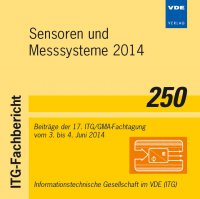Lightning-safe Monitoring of Wind Turbine Rotor Blades Using Optically Powered Sensors
Conference: Sensoren und Messsysteme 2014 - Beiträge der 17. ITG/GMA-Fachtagung
06/03/2014 - 06/04/2014 at Nürnberg, Deutschland
Proceedings: Sensoren und Messsysteme 2014
Pages: 4Language: englishTyp: PDF
Personal VDE Members are entitled to a 10% discount on this title
Authors:
Worms, K.; Klamouris, C.; Wegh, F.; Meder, L.; Stork, W. (Institute of Information Processing Technologies (ITIV), Karlsruhe Institute of Technology (KIT), Engesserstr. 5, 76131 Karlsruhe, Germany)
Volkmer, D. (Bosch Rexroth Monitoring Systems GmbH, Else-Sander-Str. 8, 01099 Dresden, Germany)
Philipps, S. P.; Reichmuth, S. K.; Helmers, H.; Bett, A. W. (Fraunhofer Institute for Solar Energy Systems (ISE), Heidenhofstr. 2, 79110 Freiburg, Germany)
Vourvoulakis, J. (Section of Electronics and Information System Technology, Democritus University of Thrace (DUTH), 67100 Xanthi, Greece)
Koos, C.; Freude, W. (Institute of Photonics and Quantum Electronics (IPQ), Karlsruhe Institute of Technology (KIT), Engesserstr. 5, 76131 Karlsruhe, Germany)
Leuthold, J. (Institute of Electromagnetic Fields and Microwave Electronics Laboratory, Swiss Federal Institute of Technology (ETH), 8092 Zurich, Switzerland)
Abstract:
We demonstrate a prototype of a lightning-safe system for condition monitoring of wind turbine rotor blades. The system uses non-conductive optical fibers instead of copper cables for powering remote electrical sensor units and for exchanging data with them. Thus, complete electrical isolation between the sensor units inside the rotor blades and a base station in the hub of the wind turbine is provided. Optical power delivered by fiber-coupled laser diodes is converted at each sensor unit into electrical power by a miniature photovoltaic cell, making 177 mW available to continuously operate a two-axes MEMS acceleration sensor as well as a low-power microcontroller (muC) for data processing. Sensor data are sent back to the base station through a fiber-optic transmitter. We successfully tested the prototype for an extended 4-month field trial inside a 1.5 MW wind turbine. This work has been realized in the framework of the project OPTOWIND supported by the German Federal Ministry for the Environment, Nature Conservation, Building and Nuclear Safety (BMUB).


